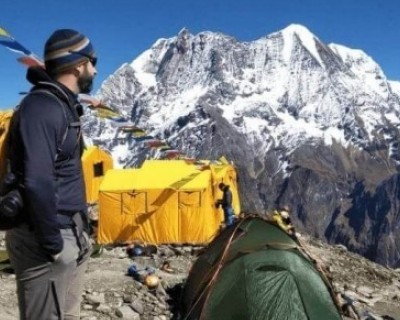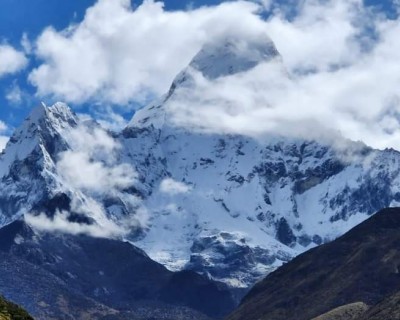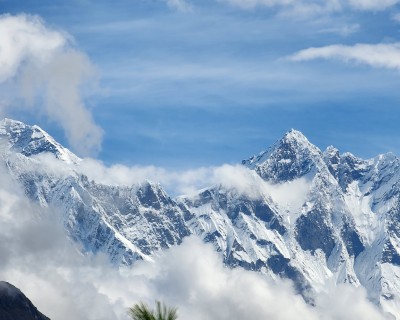It is the most confusing question everyone thinks while planning to trek in Nepal. When your Trekking in Nepal is which months to enjoy the adventure trekking in Nepal so we have listed here the season with their pro and festival you can celebrate.
Spring season
The months of the March, April, and May fall-spring season. The spring season is characterized by long days and warmer temperatures. It is the second popular time to trek and travel in Nepal, so you need a good plan n advance.
During this period, Nepal's landscapes changed their color in altitude from red to white and pink, and the dry and light green forest also changed into dark green, with the fresh environment and beauty, this made the trekking at the higher altitude more relaxed and attractive.
The temperature in the upper hills and lower mountains ranges from 16 degrees Celsius to 23 degrees Celsius. May is the warmest month of the year but also brings clouds and showers before the monsoon arrives.
During the spring season, it is generally warm at the lower altitudes and also you will experience quite moderate at the higher altitudes over 4000 meters. This month offers you mind-blowing views of the snow-capped mountains without any disturbance of the weather.
Spring season is the most beautiful season where every natural for a change, the dry forest, and tree changes into green, and the blooms of rhododendrons make the forest very colorful. Walking through the green forest you can also listen to the chirping melody sounds of the birds.
Just as winter passes you also experience some occasional snow showers. In the early spring during the March months, you will see the weather likely to be steady.
Due to the best weather and times, almost all trekking trails are busy during these times, you will see the crowded trail, and all the teahouses are at their fullest charge. It means trekking in these times you should be well prepared for the trekking plans, the advance of booking rooms in the teahouse, and many more things.
The average temperature in the spring season in the Everest Base Camp is 17 degrees Celsius with a maximum of 25 degrees Celsius during the sunny day and a minimum of -15 degrees Celsius in the morning and night above 4000 meters.
Almost all popular trekking trails of the Everest Region and Annapurna region are suitable for trekking during this time.
Pros of trekking in the spring season are:
- Warm weather and pleasant trekking conditions during the day times.
- Days are longer during March and April, which means good acclimatization and long hikes.
- Less chance of flight cancellation in the Everest region.
- A beautiful walk through the green forest covered with the blooms of rhododendrons, enjoying the morning melody sounds of birds.
- Fewer trekkers compared to the Autumn season means more chances to explore the remote corner of the Himalayan.
- The snow that accumulated during the winter will melt away by April clearing paths for the high mountain passes with a clear view.
Festivals and events during the spring season
- Nepalese New Year falls and is celebrated in April.
- Buddhist biggest festival Buddha Jayanti is celebrated in Lumbini and Kathmandu in April.
- Ghode Jatra best entertaining Jatra is celebrated in Kathmandu in March.
- The festival of Color is also celebrated across the cities and the streets around Nepal in March.
- The Dumji festival is celebrated in the Everest region in May.
- The famous three-day- Teji festival is celebrated in the Upper Mustang. Here you can enjoy the dance of monks.
Summer season
Summer season is also known as the rainy or monsoon season in this time you will see the earth surfacing receiving a large number of rainfalls. The months of June, July and August.
The summer season in Nepal comes with high temperatures and uncomfortable conditions. The high mountain region is usually covered in the cloud and the lower trekking routes are generally muddy and slippery however, trekking in this season you will experience the glory of the Himalayan.
Due to the geographical diversity, some regions in the Himalayan lie in the rain shadow so it will be best to trek in this region like Annapurna and Mustang.
In the north of Nepal, there is the great Himalayan vista. The Manag, Mustang, Dolpa, and Annapurna region of Nepal lies in the rain shadow. So the summer is the best time to go trekking in these regions.
Due to Nepal's topography, rain in Nepal offers occurs at night resulting in clear and beautiful morning scenery. Offer clean and clean environments.
The excess rainfalls can provide you with plenty of opportunity to enjoy the spectacular views of the rainfalls.
Also, this period is perfect for the photographers, fewer trekkers means quite a peaceful trekking trail and they can capture each moment without any disturbance. As in the higher valley blooms with the flowers and the lush vegetation make this time perfect to capture all the natural beauty without any disturbances. With the benefit you will also face some challenges, heavy rainfalls mean a high chance of the leeches and bugs in the forest so while trekking in the rainy season make sure to carry some lotion to prevent these.
Pros for Trekking in the summer season
- Low chance of altitude sickness compared to the other season because of the summer.
- Quite less chance of avalanches
- Less number of travelers and trekkers on the trial means you will get a beautiful chance for more intimacy and peace with nature.
- Mind-blowing views of the snow-capped mountains with a clean and clear sky.
Festival and Events during the summer
- Paddy plantation day (Ropai Jatra) is celebrated in June all around the world.
- Nag Panchami and Jania Purnima festivals fall in July.
- Gaijatra- the great festival of cows is celebrated in August
Autumn season
The autumn season in Nepal starts from September to November. It is the peak season just like the spring season, the most popular trekking trail is also very crowded. Besides this, it is one of the best and most popular times to visit and enjoy trekking in Nepal.
During these times, the weather is very pleasant, beautiful, and comfortable. But sometimes the temperature gets hot at the elevation of 300 meters. The temperature in the upper hill and the lower mountain ranges from 15. C to 24. C.
Autumn is the best time to go trekking in Nepal because of the clear days and also these seasons afford incredible snow-capped mountain views from every angle.
During this time, the average temperature in the Everest Base Camp is 15. C and the temperature ranges from 20 degrees Celsius on a sunny day to -10 degrees Celsius at night at an altitude of more than 4000 meters.
Being the best time to visit with the pleasant weather and warm conditions, many trekking trails are very crowded so while trekking in this time you can expect the prices of everything to be slightly expensive compared to buying in the other season. Most of the Tea houses are full, which makes it quite challenging to find a room or if you find a room then you may have to share it with your friends. So booking the room will help you a lot while trekking in Nepal during the Autumn season.
Pros of trekking in Autumn Season
- The weather is pleasant, stable, and sunny
- The day tends to be warmer
- The trekking trail is filled with greenery and is not dusty anymore
- Clear views of the blue sky and breathtaking views of the snow-capped mountain peaks.
Festival and Events during the Autumn season
- Teej-the festival of women is celebrated by Nepalese women in September
- Indra Jatra- the great festival of the living goddess is celebrated in the Kathmandu Durbar Square during September
- Two major festivals of Nepal-Dashain and Tihar are celebrated during September/October
- In the Everest region, Mani Rimbu festival is celebrated during October/November.
Winter season
Winter in Nepal starts from December to February. The days will be shorter and nights tend to be lower, you will see lots of snow on the trail. So this season is not recommended for trekking at higher altitudes.
The weather during this time is fairly stable and dry, it is quite possible to trek the classic route to Everest Base Camp. The average temperature on sunny days starts from 15 degrees Celsius and at night times the temperature ranges from -20 degrees Celsius to -30 degrees Celsius.
The coolness of the weather depends upon how high you want to trek, the weather and temperature during this time are quite unpredictable, which it means keeps changing but when you trek in the lower region then the temperature is moderate
The views of the snow-capped mountains are often covered with snows offering you a great opportunity for the snowy scenery.
Due to the high snow level, the high passes in the trek are usually closed at the high altitude. Also, the people living in the high altitude of the popular trekking trails migrate to the lower altitude in Nepal. So many short treks are a great choice for the winter season. it is believed that winter is the best time to trek the south of the Everest, Solukhumbu area, and other shorter trek in the Annapurna region.
However not in the high altitude but it is the best time to explore the beauty of the lower altitude trek in Nepal.
If the extreme cold doesn't bother you and want to avoid the crowds, or want to trek on the peaceful trail without any disturbance, if you are an extreme adventure lover then trekking during the winter will be fruitful for you. But trekking in the winter requires more planning, more gear, and equipment than any other time.
Trekking in the winter season if you are going hiking and trekking over 4000 meters, then you are suggested to take a professional guide cause there is a high possibility of causing many diseases and hazards. As most of the trail is also lost in the snow.
Pros of trekking in the Winter season
- Winter is quite stable and clear
- The snow-capped mountain views are perfect.
- Fewer people on the trail means the best time to enjoy the peaceful trail.
- Enjoy the special winter discount by the teahouse along the trail.
Festivals and Events during the winter season
- Tamu Loshar- the great festival celebrated by the Gurung community in Nepal falls in December.
- Christmas and New Year are celebrated across the nation.
- The street festival is celebrated in the Pokhara at the end of the year around December 27.
- Mageshangrati- the greatest festival of Hindu is celebrated during the mid-January.
Required permit for Trekking In Nepal
Police Checkpoints during the trekking are numerous and unavoidable and also officers can check your permit at any time and will charge a fine of double the normal cost if you are caught without the proper trekking permits. If you get caught then do not try to bribe officers or police personnel, it might get you in more serious trouble than you think so it is best to purchase the national park entry and TIMS(trekker's Information Management System card) for running your trek smoothly.
TIMS card
TIMS (Trekker's Information Management System (TIMS) card is required for doing several treks in Nepal.
Normally you will see the two types of TIMS cards:
- Green which means Independent trek cost- RS 2000
- The blue card refers to the trekkers who are part of the tour with a guide cost-RS 1000
Point to be noticed, the individual TIMS card is only obtained from the Nepal Tourism Boards' office in Kathmandu and Pokhara and the Trekking Agent Association of Nepal office. You will not get it from the trekking agent as they are not legally authorized to obtain individual TIMS however some trekking agents may offer the individual TIMS. From the information about fetting the TIMS card, you can go site TIMS Nepal and visit there. But while getting the TIMS card make sure to bring all the required insurance documentation, a photocopy of your passport, and passport-sized photographs when applying for it.
Tickets while trekking in Annapurna, Khumbu, and Langtang
Trekking in this area only requires the national Park entry ticket (Which price varies per park) as the Khumbu municipality fee. The fee costs around 2000 Nepali Rupees. While trekking in the Everest region the visitors do not need TIMS for Everest Base Camp and so on.
Trekking in restricted areas
Some restricted areas such as Dolpa, Mustang, Manaslu, and Kanchenjunga don't require TIMS care only you should have trekking permits, which can be obtained only through the trekking agents.
Trekking peaks
There are around 33 snow-mountain peaks in Nepal which range from 5650 to 6500 meters and are classified as Trekking peaks. The climbing peaks cost around USD 350 for one to four members an additional USD 40 each for the next four members and USD 25 each for the final four members. To succeed the peak climbing in Nepal requires a qualified "climbing guide", permit, and deposits to cover the camp waste disposal.
Fitness for Trekking in Nepal
There are hundreds of trek than one can trek in Nepal, from very short day hikes around Kathmandu and Pokhara to the Great Himalayan Trail. Trekking in Nepal, some routes is easy and can be done by anybody while others require the trekkers to complete and also some need mountaineering experience.
howere, the trek they chose, all the trekkers visiting Nepal should be in at least moderate physical shape. Trekking anywhere in Nepal is physically demanding but most of the trek in Nepal would be considered difficult by the other countries because of the ascending and descending as well as high altitude. Being in bad shape it leads to serious injury or a medical emergency in the case. So it is very best to prepare mentally and physically to enjoy the experience of trekking in Nepal.
The amount of physical preparation depends on the trek that you choose to trek. generally, you should paper more while you plan to trek longer and the higher trek. for example, 15 days, of high-altitude treks like the Everest Base camp trek or Annapurna Circuit trek, for doing these treks one should be getting 4-5 days a week of cardio exercise for at least a month before starting the trek. for the lower altitude trek or the other shorter trek near Kathmandu and the Pokhara valley, you just should be in good shape to walk for several hours enough for the short hiking. For more specific information on the training and Physical preparation, it is very best to consult with your doctor and get more knowledge about it.
Medical Kit while Trekking in Nepal
In a short trek like trekking ara outside Kathmandu, hiking near the valley has a few options for good care but trekking in the most popular trekking destination in Nepal is fairly remote and lack of good medical facilities and good ones are scarce in this area. So it will be very good for foreign trekkers to carry their medical kit with them while trekking or traveling outside the Kathmandu valley. And also a suggestion for trekking at a high altitude don't forget to carry all the necessary medicine and medical kit in the mountains. Many of these can be purchased in Kathmandu and Pokhara.
Traveling and Trekking medical kits in Nepal should be included:
- Basic First aid things like bandages, sterile cleaners, gauze, tape, etc.
- Band-aids and blister care
- Antifungal cream
- Cold tablets and nasal decongestants
- Prescription medicines that an individual is taking
- Paracetamol and aspirin for pain relief.
- Diamox-especially for hiking above the 3500meters.
- You can also bring other medical that you require while trekking in the high altitude.
For successful and beautiful trekking in Nepal, you should know many more things, like the best time to visit, difficulty, good physical and mental fitness, know about Nepal's food and water, and many more. So if you plan to trek to Nepal and want to know more in detail then please mail us: at [email protected]








